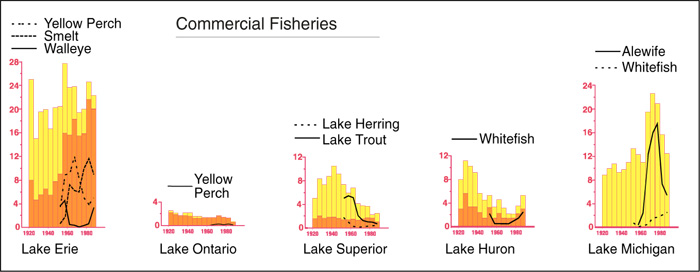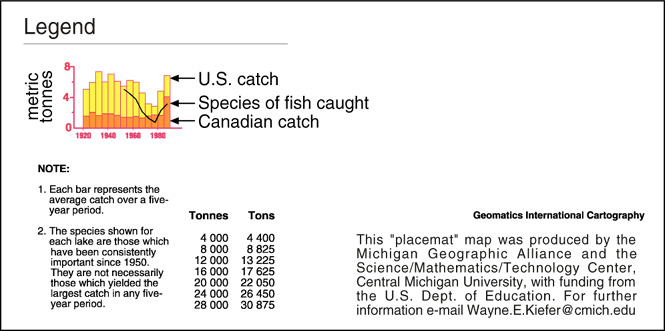In the past the Great Lakes supported important commercial fisheries, with plentiful lake trout, sturgeon, whitefish, lake herring, pike, and walleye. Most of the native fish populations in the lakes were severely depleted by the mid-1900s, and today there is little commercial fishing. The lakes are an important recreational resource. Thousands of summer and year-round homes line the shores of the lakes, and in summer millions of people flock to the lakes for powerboating, sailing, fishing, and swimming.
The charts below above show fish catch by lake and by species for the years 1920 through 1990.


Saga of the Sea Lamprey
Lake trout historically were the top predator in Lake Superior and supported valuable
commercial, subsistence, and sport fisheries.
Although more than 140 non-native species have entered the Great Lakes,
the sea lamprey is considered the most harmful. Lampreys are eel-like animals that have
naked, scaleless bodies (see photo below). During part of their life cycle, sea
lampreys are active predators, and are parasitic, feeding only on the blood of fish. They
attach to their host, usually a Lake Trout, and extract blood and tissue fluids. They do
not usually kill their prey, but feed until the animal is weak and then detach.
Starting in the 1920's, sea lampreys began to invade the upper Great
Lakes, and their predation, combined with fishery exploitation, caused the collapse of
most lake trout populations throughout the basin. They likely entered Lake Ontario from
the Atlantic Ocean through the New York State barge canal system in the 1800's, and
entered the upper Great lakes after the Welland Canal was completed in 1829, allowing
passage past Niagara Falls. By the 1950's, predation by sea lampreys and overfishing
combined to exterminate lake trout in Lakes Ontario, Erie, Huron, and Michigan, and
depleted their numbers in Lake Superior. These declines caused economic devastation and a
severe imbalance of predator and prey species.
The fish populations of the lakes have changed dramatically in the 20th century; changes
were wrought at first by overfishing and then by the introduction of exotic species. Most
notable of the latter was the parasitic sea lamprey, which probably entered the lakes via
the Erie Canal and spread following the completion of the new Welland Ship Canal in 1932.
The sea lamprey virtually eliminated lake trout from Lakes Huron and Michigan. Canadian
and American government programs, instituted in the 1970s, have reduced the number of
lampreys.
The decline in the lake-trout population allowed another invader, the alewife, to
flourish, unconstrained by any natural predators. Alewives entered the lakes through the
St. Lawrence Seaway and the Welland Ship Canal. Alewife populations have been brought
under control by the coho salmon, imported into the lakes in the 1970s, which has become
the dominant predator and an important sport fish.
Without sea lamprey control, efforts to reestablish lake trout failed.
Given the scale of this ecological disaster, the Great Lakes Fishery Commission was
established in 1955 to control sea lamprey and restore lake trout populations. Priority
was given to Lake Superior, since lake trout populations had not been completely
eliminated there. During the late 1950's and 1960's, the USGS Great Lakes Science Center
worked closely with the Great Lakes Fishery Commission to identify a selective chemical to
control sea lamprey larvae in streams. After scientists tested more than 6,000 chemicals,
they determined 3-trifluoromethyl-4-nitrophenol (TFM) the most suitable and developed it
for field use. Shortly after TFM application to larval populations, sea lamprey numbers
began to decline in Lake Superior, allowing for the reintroduction of lake trout through
plantings of hatchery-reared fish and protection of remnant stocks. These field programs
were later assumed by State and tribal management agencies and used as a model to develop
assessments in other jurisdictions.
Ongoing analysis of these important field data led to the decision in
1996 to discontinue stocking federally produced hatchery lake trout in most areas of the
lake. Results indicated that lake trout restoration is well on its way in most areas of
Lake Superior and that protection of self-reproducing wild lake trout populations from
over-exploitation and sea-lamprey predation is the primary strategy to foster further
restoration.

Source: Unknown
Highly prized lake trout have been successfully restored in Lake
Superior through the research of USGS scientists working closely with management agencies.
This combined science and management approach is now being adapted to other lakes and
species in a basin-wide effort to restore native fish species.
Parts of this page are from the Encarta Encyclopedia: www.encarta.msn.com
This material has been compiled for educational use only, and may not be reproduced without permission. One copy may be printed for personal use. Please contact Randall Schaetzl (soils@msu.edu) for more information or permissions.